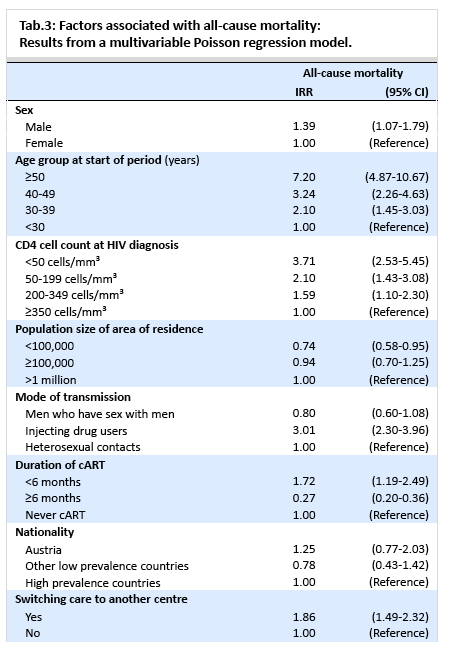 |
 |
 |
| |
Switching HIV Clinics Linked to Higher Mortality in Large Austrian Study
|
| |
| |
7th IAS Conference on HIV Pathogenesis, Treatment and Prevention, June 30-July 3, 2013, Kuala Lumpur
Mark Mascolini
People who switched from one HIV clinic to another had an 86% higher death rate than people who stayed at the same clinic, according to results of a 5-year 4891-person study in Austria [1]. Overall mortality dropped from 2005 to 2010. AIDS remained the leading cause of death, followed by non-AIDS cancers.
More than 80% of HIV-positive people in Austria receive care in one of seven HIV clinics. As in many similar countries, people often move from one region to another. To determine mortality trends over the years and the impact of changing residence on mortality, Austrian HIV Cohort Study investigators conducted this analysis of people in care from 2005 through 2010. They cross-checked death registry data for people who stopped returning for clinic visits.
The study involved 3935 people who never switched HIV centers during follow-up and 956 (19.5%) who did. About 27% of study participants in both groups were women. The clinic-switch group had a significantly higher proportion of people infected with HIV while injecting drugs (30.4% versus 15.1%, P < 0.001) and a significantly lower proportion infected during heterosexual sex (31.3% versus 42.3%, P < 0.001). About one third in each group acquired HIV during sex between men.
A moderately but significantly higher proportion of clinic switchers were Austrian (80.6% versus 74.5%, P < 0.001), and a slightly but significantly lower proportion of switchers came from countries with high HIV prevalence (8.9% versus 11.2%, P = 0.036). Average follow-up was significantly longer in the switch group than the nonswitch group (4.51 versus 3.98 years, P < 0.001), and lost to follow-up lay between 12% and 13% in both groups. A higher proportion of switchers had taken antiretroviral therapy for at least 6 months (79.3% versus 73.7%, P < 0.001). And among people ever on treatment, switchers had a significantly greater average number of antiretroviral interruptions (1.07 versus 0.65, P < 0.001).
During almost 20,000 person-years of follow-up, 385 people (9.8%) died. Median age at death was 46.4 and median latest CD4 count 203. Overall mortality stood at 1.93 per 100 person-years, meaning almost 2 of every 100 people died every year. Mortality dropped from almost 3 per 100 person-years in 2005 to under 2 per 100 in 2010. Among individual causes of death, mortality was highest for AIDS (0.56 per 100), followed by non-AIDS malignancies (0.31 per 100), non-AIDS infections (0.20 per 100), and hepatitis-associated illness (0.16 per 100).
AIDS illnesses accounted for 36.7% of deaths in the clinic-switch group and 24.4% in nonswitchers (P = 0.010). Rates of other causes of death did not differ significantly between switchers and nonswitchers, including non-AIDS malignancies (13.7% versus 17.5%), non-AIDS infections (10.1% and 10.6%), hepatitis-associated illness (9.4% and 7.7%), and cardiovascular disease (3.6% and 5.7%).
In an analysis adjusted for age, gender, CD4 count at HIV diagnosis, population size of residential area, HIV transmission route, antiretroviral duration, and nationality, average mortality proved substantially higher in clinic switchers (3.22 per 100, 95% confidence interval [CI] 2.68 versus 3.75) than in people who used only one HIV clinic during follow-up (1.57 per 100, 95% CI 1.37 to 1.77). Excluding injection drug users from this analysis did not change the result.
Multivariate Poisson regression analysis determined that clinic switchers had 86% higher mortality than people staying in the same clinic (incidence rate ratio [IRR] 1.86, 95% CI 1.49 to 2.32). People who lived in areas with a local population under 100,000 versus over 1 million had a 26% lower death rate (IRR 0.74, 95% CI 0.58 to 0.95). Nine other factors independently predicted higher mortality in this analysis at the following IRR (and 95% CI):
-- Male vs female gender: IRR 1.39 (1.07 to 1.79)
-- HIV through injection drug use vs heterosexual sex: 3.01 (2.30 to 3.96)
-- Age 50 or older vs under 30: IRR 7.20 (4.87 to 10.67)
-- Age 40 to 49 vs under 30: IRR 3.24 (2.26 to 4.63)
-- Age 30 to 39 vs under 30: IRR 2.10 (1.45 to 3.03)
-- CD4s under 50 vs over 350 at HIV diagnosis: 3.71 (2.53 to 5.45)
-- CD4s 50 to 199 vs over 350 at HIV diagnosis: 2.10 (1.43 to 3.08)
-- CD4s 200 to 349 vs over 350 at HIV diagnosis: 1.59 (1.10 to 2.30)
-- Antiretroviral duration under 6 months vs naive: 1.72 (1.19 to 2.49)
Nationality did not affect mortality in this analysis.
Whether the clinic-switch effect holds true in other developed (and developing) countries with similarly mobile populations is difficult to say. One could speculate that people who switch clinics had to move to seek employment or for other reasons indicating socioeconomic instability. The researchers cautioned that they could not adjust their analysis for socioeconomic and lifestyle factors and that the relationship between antiretroviral interruptions and switching, and the resulting impact on survival, remain unknown. They added that their analysis may underestimate mortality because they could not track people who left Austria and may have died.
The Austrian HIV Cohort Study Group investigators called for further research to determine why people switch treatment centers and why that affects clinical outcomes.
Reference
1. Sturm G, Zangerle R, for the AHIVCOS Group. Mortality in the combination antiretroviral therapy era: will switching to another treatment centre become a risk factor? 7th IAS Conference on HIV Pathogenesis, Treatment and Prevention, June 30-July 3, 2013, Kuala Lumpur. Abstract TUPE255. http://pag.ias2013.org/EPosterHandler.axd?aid=1049
nference on HIV Pathogenesis, Treatment and Prevention, June 30-July 3, 2013, Kuala Lumpur. Abstract TUPE255. http://pag.ias2013.org/EPosterHandler.axd?aid=1049





|
| |
|
 |
 |
|
|